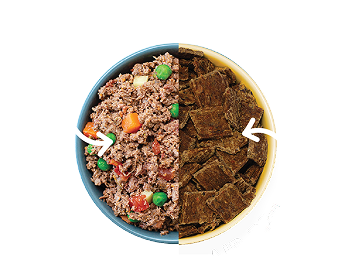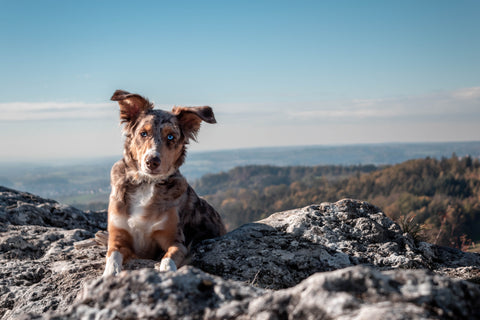
Let's Talk Toxicity in Toys
Tennis balls: electric green, slightly furry, and a famous favorite of many dogs. You probably have a few lying around. But did you know that tennis balls are not quite as benign and friendly as they seem? While throwing around a tennis ball for your dog sometimes isn’t a recipe for guaranteed disaster, tennis balls aren’t made with dogs in mind, and the "made for sport" kind of tennis ball can be problematic from a toxicity and choking perspective. However, the truly scary thing is that many toys that are actually intended for dogs are more toxic than your average tennis ball! What can be done? Are any toys safe? We’re here to help.
THE CLASSIC SPORT BALL
Sport tennis balls are made to withstand high-speed contact with racquets and tennis courts, and must be tough to maintain their shape and integrity for many games. The fluff on the outside of the ball helps slow the ball in the air, gives it a spin, and (unintentionally) collects dirt, sand, and grit when you bring it to the park or beach.
This build-up can become a problem for dogs who spend a lot of time playing, chomping, and shredding tennis balls. The dirt accumulated in the fuzz of the ball can begin to mimic sandpaper and gradually wears down teeth, known as blunting. Blunting can cause dental problems later on. This is primarily a concern for truly ball-crazy dogs, as the consistent gnawing, catching, and chewing on of these dirty balls can cause blunting of the teeth.
Blunting can also occur with soft toys such as fabric frisbees that also accumulate grit, so if you've got a pup who adores fetching toys that are softer or covered in fiber, switching to rubber toys may pay off in the long run.
If that doesn’t convince you, consider your dog's stomach - getting a bunch of sand or dirt in the tummy isn't much fun and can potentially upset some pups with sensitive GI tracts. So even for pups who aren't ball fiends, there can still be an issue with toys that collect dirt.
Solutions:
- Bring more than one ball or toy, and switch it out with another when one gets too gross.
- Switch to rubber or smooth balls or toys.
WHAT ABOUT TOYS MADE SPECIFICALLY FOR DOGS?
Regardless of who or what the toy is made for, if there's fiber on it, it can collect grit and grime and cause issues. However, what’s most important to know is that dog toy quality is not universally regulated, and many of the toys made “for” dogs are not actually very safe. As it stands, there are no official rules in the US to govern the safety of pet products. This means that domestic manufacturers are not required by law to test their products for dangerous substances, and there is also no government-imposed testing for products manufactured in other countries.
Since there aren’t legal definitions surrounding pet products, it’s easy to be fooled by branding. For example, the use of terms such as "natural" is left to the interpretation of manufacturers. A sampling of hundreds of pet toys and accessories by the Michigan-based Ecology Center, showed a serious chunk of products marketed as “natural” containing “alarming levels” of lead and other harmful chemicals such as formaldehyde.
HOW TO IDENTIFY SAFE DOG TOYS
So how can you be sure the toys in your house are safe? As with many things related to pup health, the impetus is on you as the consumer to find and support companies who have imposed good quality control and thorough testing.
Major big box pet stores often claim to test all of their products before allowing them onto the shelves, but their methods are not public, so you may want to proceed with caution. Small, independent pet stores are more likely to provide well-researched products and better transparency. Check out the mission statements of any store or brand you shop at, and look for information about transparency and quality standards. You can also contact sellers and ask for more information and their stance on quality control and testing practices for toxic chemicals and harmful materials.
There are companies out there who have prioritized safety-conscious manufacturing processes and transparency on their testing methods. One of our favorites is PlanetDog, who have taken it upon themselves to produce products that are entirely non-toxic. Here are a few guidelines on identifying and choosing quality pet toy suppliers:
- Look for toys that bear the "B-Corp" logo. If you see a toy manufactured by a B-Corp, it is more likely to be a safe bet.
- Support your local pet supply companies. Local suppliers are more invested in the health and happiness of the doggos that are in their lives and stores on a daily basis.
- Compile a list of safer companies and use it as a roadmap. Many safe suppliers will also recommend other brands they trust on their websites. We recommend you check out West Paw and Earthdog to get you started.
MOVING FORWARD
Keeping retailers and manufacturers honest and on their toes can be hard - that's why it's important to let them know that you demand safe materials for your pet's toys and accessories. You can help do this by actively seeking out and choosing companies that honor quality, safety, and transparency, and by contacting and demanding better from companies who don't. Every choice makes a difference!
Important: Please remember that all toys, to some extent, can pose potential danger to the user - dog or human! Always supervise your pet for safety.
Top Stories

Why Do Dogs Lick Their Paws?

Why Do Dogs Whimper & Make Noises in Their Sleep?

Healthy Vet-Approved Homemade Dog Food Recipes

How To Cook Sweet Potatoes for Dogs






















